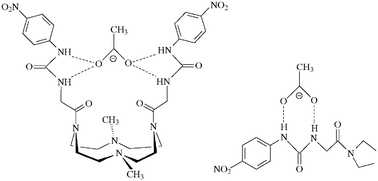New branched macrocyclic ligand and its side-arm, two urea-based receptors for anions: synthesis, binding studies and crystal structure†
Abstract
The synthesis and characterization of the two new hosting molecules for anions

* Corresponding authors
a
Institute of Chemical Sciences, University of Urbino, P.zza Rinascimento 6, Urbino, Italy
E-mail:
vieri@uniurb.it
b Department of Energy Engineering ‘Sergio Stecco’, University of Florence, Via S. Marta 3, Florence, Italy
c Institute of Pharmaceutical Chemistry, University of Urbino, P.zza Rinascimento 6, Urbino, Italy
The synthesis and characterization of the two new hosting molecules for anions

 Please wait while we load your content...
Something went wrong. Try again?
Please wait while we load your content...
Something went wrong. Try again?
M. Formica, V. Fusi, E. Macedi, P. Paoli, G. Piersanti, P. Rossi, G. Zappia and P. Orlando, New J. Chem., 2008, 32, 1204 DOI: 10.1039/B719342D
To request permission to reproduce material from this article, please go to the Copyright Clearance Center request page.
If you are an author contributing to an RSC publication, you do not need to request permission provided correct acknowledgement is given.
If you are the author of this article, you do not need to request permission to reproduce figures and diagrams provided correct acknowledgement is given. If you want to reproduce the whole article in a third-party publication (excluding your thesis/dissertation for which permission is not required) please go to the Copyright Clearance Center request page.
Read more about how to correctly acknowledge RSC content.
 Fetching data from CrossRef.
Fetching data from CrossRef.
This may take some time to load.
Loading related content
